| |
|
|
| |

by Erika Butler - Dreibergen Rottweilers |
 |
| There is plenty of inaccurate information circulating on the internet about Rottweilers with natural tails, much of it written by people that have only owned docked Rottweilers and would NEVER consider owning a Rottweiler with a natural tail. I stopped docking in 1999 and I have owned only Rottweilers with natural tails for the past 10 years, almost immediately after the law change in Germany. I have been to countless shows with an abundant number of tailed Rottweilers, including the Klubsieger Show in Germany and the IFR World Show (where tails are the norm) and have seen the varieties of different tail carriages and sets. |
| There was an article on the internet that appeared when the FCI Breed Standard was first changed that describes the disastrous effect the natural tail would have on our breed. The article describes tail sets that don't exist in quality breedings any more than they existed prior to the standard change and depicts structure changes that would be necessary for a tailed dog that simply aren't true. |
This photo is from an article on a anti-natural tail website depicting the Rottweiler that "we recognize"

This drawing describes a tail set as seen in Sweden
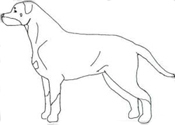
This tail only belongs on an Akita!
This photo describes the tail as an elongation of the topline.
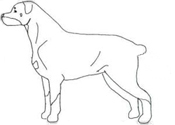 |
| A Rottweiler's natural tail is carried hanging while at rest, and often over the back when excited. It normally has a slight curve. A Rottweiler does not hold it's tail in a stiff position sticking straight out from the body, but it can be captured appearing to stick straight out by a camera, with the picture taken at exactly the right moment, as the tail wags back an forth |
Some additional reasons the against natural tails:
"To add a long, heavy tail to the structure described in the standards would change the center of gravity, moving it towards the rear of the dog..."
"...would lessen the Rottweiler's ability as an endurance trotter, unless the croup we desire today changes."
"...the Rottweiler's presently desired croup and tail set would have to change to accommodate an undocked tail."
"I also would expect to see the undocked Rottweiler change proportion, too, and become a longer dog."
The author would have us believe that a natural tailed Rottweiler might look like this |
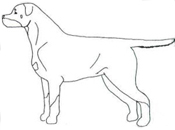
The truth is, this Rottweiler has a falling croup, and was born with a falling croup with or without a tail!
Does this croup somehow become more correct without the tail?
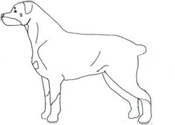 |
The structure is already determined at birth, the genetics for the croup and tail set were already set in place before the puppy arrived in this world. The puppy was born with a tail and the croup remains the same whether left natural or docked by the breeder.
Using the author's own drawing, it is easy to see how correct structure remains unchanged, with or without a tail |

The authors depiction of a docked Rottweiler with correct structure |
+ 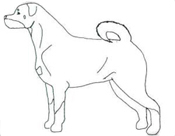 = =
The author's tail taken from the tailed dog with a falling croup |
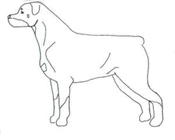
There you have it. A dog with a tail, with the same structure as the dog without the tail. |
| The tail structure can be faulty and the breed standard clearly describes a faulty tail as "kink tail, ring-tail, with strong lateral deviation" |
Ring tail without lateral deviation
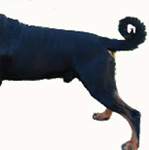 |
Ring tail with lateral deviation
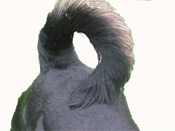 |
Kinked tail
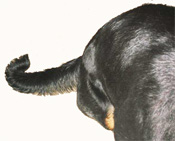 |
|
We successfully finished one of the first tailed dogs in Canada - where they allow both docked and tailed dogs in the show ring (CanCh USRC NYS'04 SWRYS'03&'04 NCRSA'04 SWRSA'05 Redwood Krest's Friday CS BH). Now there are MANY finished Canadian Champions! Both AKC and CKC judges have put up quality dogs, Friday received a 5 point major in Canada under a well known, highly regarded AKC judge. When I approached him after the show and told him "Thank you for finding my dog with the tail." he simply replied "What's not to find, he is a beautiful, correct Rottweiler and the tail doesn't make a bit of difference." Hmmm, Apparently the judges are still able to assess a dog's structure with a natural tail.
...tail selection will suddenly move from no consideration at all to major consideration in the selection of breeding stock"
We have had many litters with natural tails and have found no need to change our breeding program to accommodate some imaginary problem with the tails or structure. Despite the fact that they were previously removed, the tails still knew what they were supposed to be if left intact. Ring tails and kinked tails do occur - in some bloodlines more than others - however they have no impact on the health of the dog, they are a simple cosmetic fault.
"...a long tail would probably become injured by beating it against the wall, the table, etc."
A Rottweiler is no more prone to tail injuries than any other natural tailed dog. Would it be logical to argue that all dogs breeds should be docked to protect against tail injury? Tail sprains and injuries happen to all natural tail breeds but this has never been used as a reasonable argument to support docking of all dog breeds.
Docked or natural in the U.S. is purely personal preference. The presence of a tail has not, and will not change the structure of the breed, it is the breeders that change the structure of the breed. In the United States of America, ALL Rottweiler fanciers should striving for the same thing...
THE RIGHT TO CHOOSE!
|
| This article and all other material on this website are protected by copyright and may not be reproduced online or in print, in whole or in part without prior consent of e author |
|
|
| Rottweiler History | FCI Breed Standard | Rottweiler Eye Chart | Rottweiler Breed Type | The Rottweiler Tail |
| Return Home | Males | Females | Young Dogs | Litters | For Sale | VOM THUNDERHEART 'WORLD WIDE' | Rottweiler Info | Contact Us | Show Results | DACHSHUNDS | Customer Testimonials |
|
|
| |
|
|
























